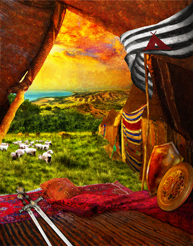 Gad גָּד
Gad גָּד
What imageries are included in the depiction of Gad?
The artwork shows the traditional tribal symbol of Gad, which is a camp: The color of his flag was white and black. The sheep and cows allude to Gad being rich in flocks. The weapons portray the account of them being brave warriors. The scenery is East of the Jordan with a view of the Dead Sea where the tribe resided.
The Meaning of the Name Gad
In Genesis 30:11, “Leah exclaimed: Good things have happened to me! So she gave him the name Gad.” A different translation states,“Leah named him Gad, meaning my luck has turned!” Gad is also translated as “good fortune comes.” According to Rashi, Gad means Mazal Tav, “good luck.” In Genesis 49:19, the name Gad, or Gedud, is referred to as “a band of followers”, “a troop is coming” or “Gad shall camp in troops.” This is in correlation to what Leah meant when she said, “Ba Gad”-for her sons now made up a whole troop. The Hebrew word Gad derived from Yegud/Yegudenu, is also a reference to his fighting strength.
The Biblical Blessings of the Tribe
Jacob’s blessing for the tribe of Gad in Gen 29:19 reads: “Gad will be attacked by a band of raiders, but he will attack them at their heels. Moses blessed them by saying: “Blessed is he who enlarges Gad’s domain! Like a lioness he will dwell; he will tear at an arm—indeed, a scalp.He has selected the best part for himself, for the portion of the ruler is set aside there; he came with the leaders of the people, he obeyed the righteous laws of the L-rd and his ordinances with Israel” (Deut. 33:20-21).
Tribal Symbols
The traditional tribal symbol is a black and white standard with a camp painted on it, a military army camp, and sometimes actual troops, but not tents, are shown.
Tribal Territory
According to Joshua 13:24-28, Gad resided on the eastern side of the Jordan River and the Dead Sea. They devoted themselves to the breeding of cattle; The tribe had large herds of cattle and sheep. When Gad arrived at the Jordan and saw the fertility of the land, they said: “One handful of enjoyment on this side is better than two on the other.” The lands of Jazer and Gilead, east of Jordan, were very suitable for grazing. Gad became a warlike tribe and fought successful battles against the Philistines. They were also said to be men of valor, brave warriors, men of war fit for battle and able to handle the shield and spear. Their faces were faces of lions, they were swift as the gazelles in the mountains, they were army commanders; the least was a match for a hundred, and the greatest for a thousand. According to I Chron. 12:8-14, some of the mighty warriors of Gad joined David when he was a fugitive from Saul’s jealousy. The territory was never secure from invasion and attacks, since to the south it was exposed to the Moabites, and like the other tribes east of the Jordan was exposed on the north and east to Aram-Damascus and later, the Assyrians. Gad also fell victim to the actions of the Assyrians, and the tribe was exiled. According to the Talmuds exile led to the disappearance of any subsequent history of the tribe.
Additional Notes
According to some, Elijah was a descendant of Gad. Moses was buried in the territory of Gad.